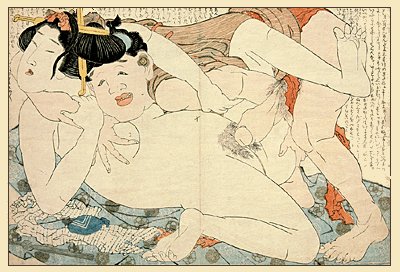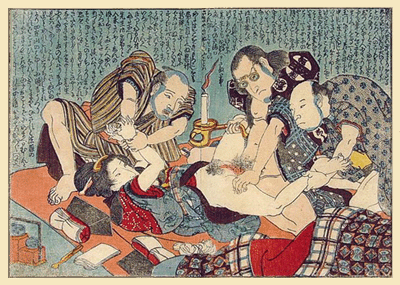|
10
Disturbing Rape Scenes in the Erotic Woodblock Genre of Shunga.
In the shunga prints that were produced during the 17th and 18th Century
the emphasis of the images was on the expression of excitement, lust and
love showing sex on a volutary basis by both partners. However, at the end
of the 18th Century erotic images slowly changed sometimes depicting
involuntary sex, in most cases showing ugly hairy men forcing themselves on
innocent young girls. The folowing ten rape designs are striking examples of
this specific theme:
|

|
Koryusai - Falconer
|
|
This chuban design by the great pioneer Isoda Koryusai (act. 1770-1780s)
from his celebrated 'Prosperous Flowers of the Elegant Twelve Seasons' published
in 1772-1773 was one of first Japanese woodblock prints depicting rape. The
image is associated with the eighth month and shows a falconer forcing down
a young girl to the ground in the middle of grass and japanese clover.
Koryusai used a somber and lurid tonality in his use of colors which,
together with the wild clawing clover perfectly symbolizes the girl's
entrapment.
|
|
Hokusai - Retard
Katsushika Hokusai (1760-1849) offers a rape scene in the large oban
format of near-comedy in his masterful series 'Fukujuso' (aka. 'Lovemaking
at New Year's' and ' The Adonis Plant') published ca. 1822-1823.
Depicted is a clownish and obviously retarded bath-house attendant
assaulting a maiden who he has long lusted for. He's holding a coin in his
ear, as was the custom of footmen who didn't possess a purse. A similar
scene can be found in Hokusai's 'Kino-e no komatsu' (Pining for
Love) which is somehow less comic.
|

|

|
Kunisada - Binded Woman
This horrifying scene from Utagawa Kunisada's (1786-1865) 'Spring,
Summer, Autumn and Winter, Prospects for the Four Seasons' -series (late
1820s) with the female victim being crucified and pinioned to a wooden stick
with her arms tied behind her back. What enhances the drama is besides the
location, somewhere deep in a forest, the fact that her tormentor has
deliberately planned his violent crime leaving no ways to escape.
|
|
Kunisada - Fox Fires
In another rape design by Kunisada portrays three untractable palanquin
bearers holding Ocho, a daughter of the owner of the Karakotoya brothel, to
the ground.
The restful setting is the surroundings of the Kurosuke Inari
Shrine. The 'fox-lights' (fox-fires) indicate the presence of the fox
spirits. This book illustration is from Kunisada's 'Shunshoku hatusne no
ume' (The Erotic Adventures of Six Women) from 1842.
|

|

|
Shigenobu - Gang Rape
|
|
Yanagawa Shigenobu's (1789-1833) oban design from 'Yanagi no arashi'
(Wind in the Willows) involves four palanquin bearers struggling to
hold down a frantic woman. One of the men (second from the left) sports some
detailed tattoos on both arms (in this picture almost invisible). The woman
is kicking and resisting strongly, but one has the sense that she might be
the one in control here.
|

|
Kuniyoshi - Candle
In this famous rape scene by Utagawa Kuniyoshi (1797-1861) from the book
'Byokei
ri goyoshi ga' (c.1830), three men in a darkened room have overpowered a
woman. The leading man, who is wearing spectacles, is penetrating his victim
while holding a candle. It is whispered among shunga devotees that this man
is actually Kuniyoshi himself.
|
|
Hokusai - Palanquin Bearers
From the shungabook series 'Manpuku Wagojin'
(Gods of Intercourse)
which Hokusai designed in 1821 this rape scene depicts two palanquin bearers
(again!) ready to rape a courtisan (prostitute).
The man holding her from
behind has a violent grip around her neck while at the same time licking her
cheek.
|

|
 |
Utamaro - Attempted Rape
In 1788 one of Utamaro's (1754-1806) most impressive early masterpieces
'Utamakura' (Poem of the Pillow) appeared in a series consisting of 12
horizontal album prints. The concerning misogynistic design of this set is
one of the most dramatic scenes with a plebeian maiden being assaulted by a
middle-aged workman while fighting with all her might.
The two protagonists
are set to a dark-grey background which heightens the dramatic effect.
|
| Eiri - Lackey
Chokyosai Eiri's (act. 1789-1801) 'Fumi no kiyogaki' (Models of
Calligraphy), dated 1801, is considered to be one of the boldest sets of
oban-size shunga known. It contains thirteen instead of the usual twelve
designs and is almost completely inspired by Utamaro's 'Utamakura'.
Also this print (see Utamaro - Attempted Rape), which is, compared to
Utamaro's classic, a more comic interpretation of a middle-aged lackey
attempting to forcibly seduce a servant girl of the same residence.
|

|

|
Hokusai - Post-rape Scene
|
|
The 'Gods of Intercouse' series is concentrated on the tales of
the two courtisans Osane and Otsubi who are from various social backgrounds.
In this case, Osane, the daughter of a rich merchant, is depicted after a
group rape. She's alone, laying against a tree and it seems like she's
strangely satisfied by this brutal experience which is emphasized by the
number of handkerchiefs around her. The tousled hair indicates her depraved
nature and is a sign that she will come to a sorry end. It remains one of
the most intriguing rape scenes in the history of Ukiyo-e shunga.
The above list doesn't include Hokusai's famous 'Dream of the
Fisherman's Wife' design and Utamaro's Kappa rape design from his Poem
of the Pillow -series (both are described in the article "10
Controversial Erotic Shunga Woodblock Prints", see article index)
because these scenes depict fantasies of the female protagonists involved
and are not on an involuntary basis.
|
|